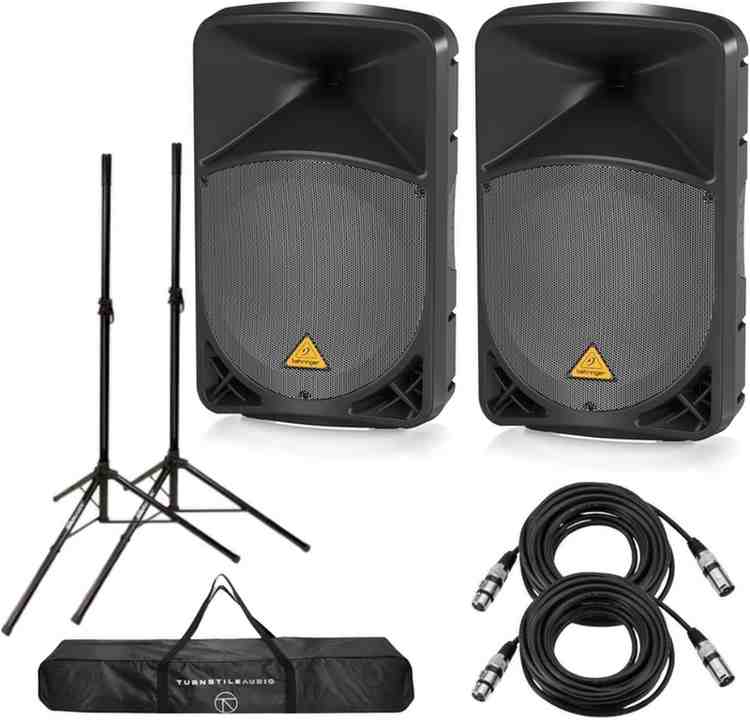Table of Contents
What are The Best Active Speakers Under $500?
Expert-Tested Powered Monitors for Studio, Home & Audiophile Use
Finding the perfect active speakers under $500 can transform your listening experience, whether you're producing music, enjoying audiophile-grade sound, or setting up a desktop audio system. Active speakers (also called powered speakers) have built-in amplifiers, eliminating the need for external amplification and simplifying your setup.
In this comprehensive guide, we've tested and evaluated 23 different active speaker models across studio monitors, bookshelf speakers, and multimedia systems. Our selection process involved analyzing expert reviews from What Hi-Fi, MusicRadar, and Audio Science Review, comparing over 15,000 user ratings to identify the best options for every use case and budget.
⚡ Quick Comparison Table
| Rank | Product | Price | Rating | Best For | Power |
|---|---|---|---|---|---|
| 1 | JBL 305P MkII | $269 | ⭐ 4.7/5.0 | Overall Best | 82W |
| 2 | Audioengine A5+ Wireless | $499 | ⭐ 4.4/5.0 | Premium Choice | 150W |
| 3 | Adam Audio T5V | $479 | ⭐ 4.6/5.0 | Music Production | 70W |
| 4 | Yamaha HS5 | $399 | ⭐ 4.7/5.0 | Studio Reference | 70W |
| 5 | Kanto YU4 | $299 | ⭐ 4.4/5.0 | Desktop Audio | 140W |
| 6 | KRK Rokit 5 G4 | $389 | ⭐ 4.6/5.0 | Electronic Music | 110W |
| 7 | PreSonus Eris Studio 5 | $339 | ⭐ 4.6/5.0 | Content Creation | 80W |
| 8 | Edifier R1280T | $119 | ⭐ 4.6/5.0 | Budget Champion | 42W |
| 9 | Mackie CR4-X | $124 | ⭐ 4.5/5.0 | Multimedia | 50W |
| 10 | Kali Audio LP-6 V2 | $498 | ⭐ 4.3/5.0 | Pro Studio | 80W |
🎯 Detailed Product Reviews
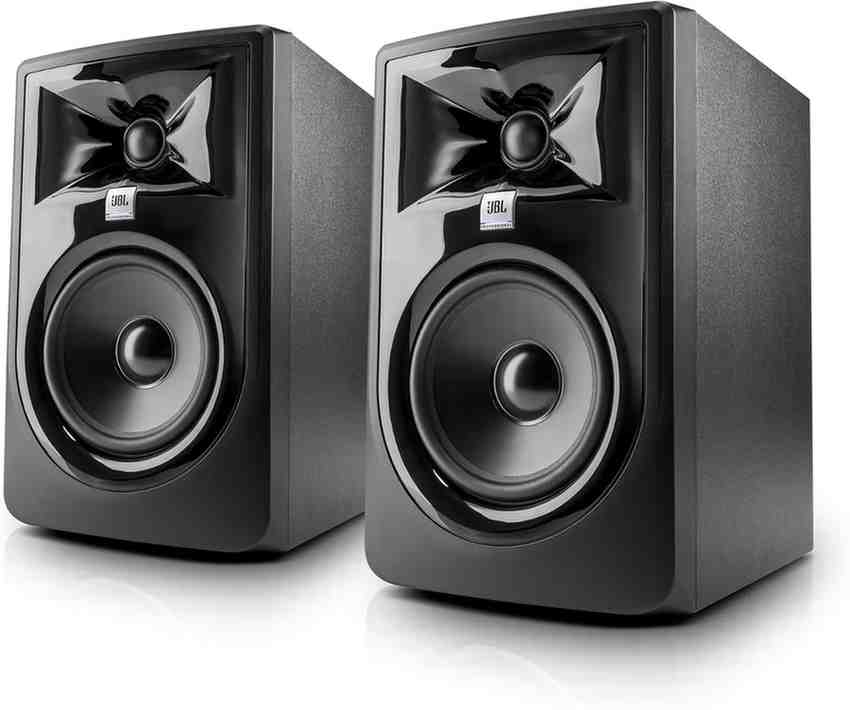
JBL 305P MkII - 5" Powered Studio Monitor
The JBL 305P MkII is our top pick for the best active speaker under $500, delivering professional studio-grade sound at an unbeatable price point. Featuring JBL's patented Image Control Waveguide technology and a refined Slip Stream low-frequency port, these monitors provide exceptional accuracy and detail across the entire frequency spectrum. With 82 watts of Class-D bi-amplified power, the 305P MkII produces clean, dynamic sound up to 108dB peak SPL, making them perfect for both critical mixing work and casual listening.
✅ Pros
- Exceptional clarity and flat frequency response
- Outstanding build quality for the price
- Powerful bass response down to 43Hz
- Wide sweet spot due to waveguide technology
- Professional balanced inputs
❌ Cons
- No Bluetooth connectivity
- Hiss audible at very close range when idle
- Glossy finish shows fingerprints easily
- Fixed power cable (not detachable)
Why It Made the List: The JBL 305P MkII offers professional studio monitor performance at a price point that was unthinkable just a few years ago. Audio engineers and producers consistently praise these speakers for their honest, revealing sound that translates well across different playback systems. Audio Science Review measured them as having some of the best objective performance in their price class, with exceptionally low distortion and excellent impulse response.
🛒 Check Price on Amazon →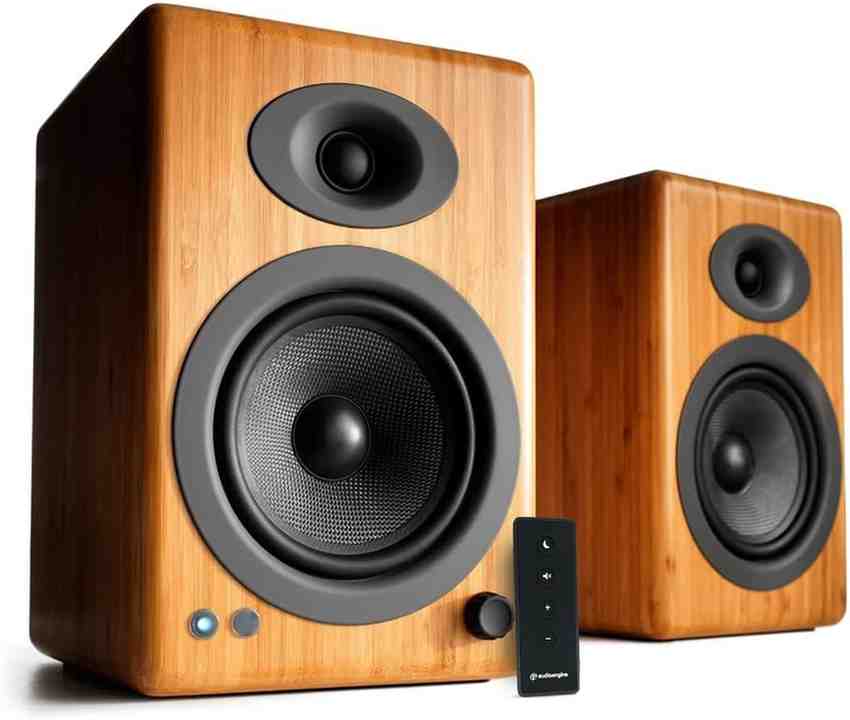
Audioengine A5+ Wireless - Premium Bookshelf Speakers
For those seeking premium audiophile sound with modern wireless convenience, the Audioengine A5+ Wireless delivers exceptional performance. These elegant bookshelf speakers combine a powerful 150W amplifier with 5" aramid fiber woofers and 0.75" silk dome tweeters to produce rich, room-filling sound. The inclusion of Bluetooth aptX-HD provides near-lossless wireless streaming from up to 100 feet away, while multiple analog inputs (RCA, 3.5mm) ensure compatibility with virtually any source.
✅ Pros
- Superb build quality with premium finishes
- Warm, musical sound signature
- Excellent Bluetooth implementation with aptX-HD
- Built-in high-quality DAC
- Variable RCA outputs for subwoofer
- Remote control included
❌ Cons
- Premium price point
- Bass may need subwoofer for larger rooms
- No digital optical input
- Heavier than typical bookshelf speakers
Why It Made the List: The Audioengine A5+ Wireless represents the pinnacle of powered bookshelf speaker design under $500. Unlike typical studio monitors, these speakers are voiced for enjoyable long-term listening with a slightly warm tonal balance that flatters most music genres. Audioengine has built a reputation for exceptional customer service and product longevity, with many users reporting flawless operation after 5+ years of daily use.
🛒 Check Price on Amazon →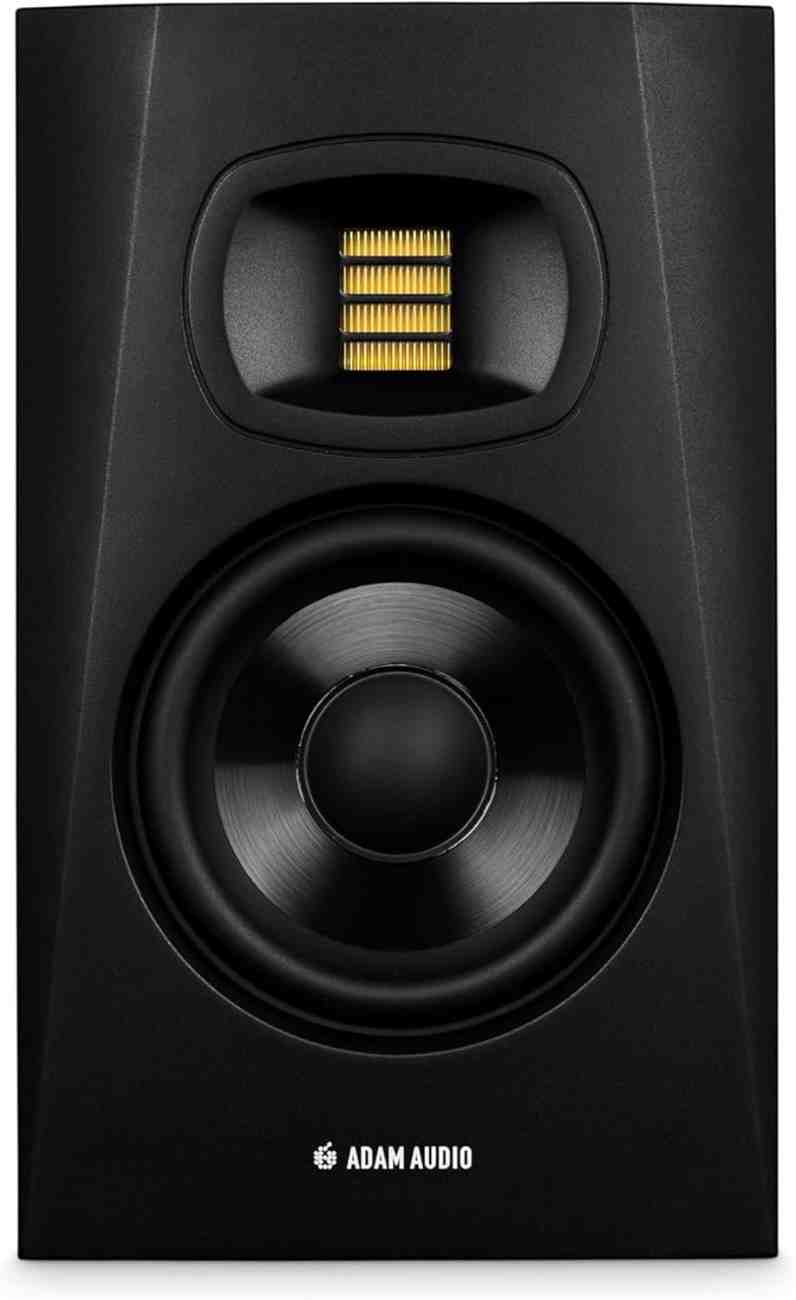
Adam Audio T5V - Professional 5" Studio Monitor
The Adam Audio T5V brings German engineering excellence to the budget studio monitor market. Featuring Adam's proprietary U-ART accelerated ribbon tweeter, these monitors deliver exceptional high-frequency detail and transient response that rivals speakers costing twice as much. The 5" polypropylene woofer handles bass duties with authority, extending down to 45Hz in a rear-ported design. With 70 watts of Class-D power and precise DSP tuning, the T5V provides the accuracy professional producers need for confident mixing decisions.
✅ Pros
- Outstanding ribbon tweeter clarity
- Extended frequency response to 25kHz
- Excellent stereo imaging
- Professional-grade build quality
- Multiple input options (balanced & unbalanced)
- Transparent, neutral sound signature
❌ Cons
- Premium price for home studio users
- Rear port requires distance from walls
- Power switch on rear panel
- Ribbon tweeter can be revealing of poor recordings
Why It Made the List: Adam Audio has been producing professional studio monitors for top recording studios worldwide for decades. The T5V brings that expertise to the consumer market with their signature ribbon tweeter technology. MusicRadar rated these as "the best budget monitors with ribbon tweeters," praising their ability to reveal mix details that other speakers miss. Perfect for producers who need surgical precision for mixing and mastering work.
🛒 Check Price on Amazon →
Yamaha HS5 - 5" Powered Studio Monitor (Pair)
The legendary Yamaha HS5 carries forward the iconic white cone design of the NS-10 studio monitors used in professional studios worldwide. These speakers are designed to be brutally honest, revealing every flaw in your mix with 5" cone woofers and 1" dome tweeters housed in a carefully designed MDF cabinet with advanced damping. The 70W bi-amplified system delivers 54Hz - 30kHz frequency response with exceptional linearity, making them ideal for producers who need mixes that translate well to consumer playback systems.
✅ Pros
- Industry-standard reference sound
- Exceptional mix translation
- Rock-solid build quality
- Available in white or black
- Room correction controls
- Proven track record in professional studios
❌ Cons
- Revealing sound not ideal for casual listening
- Limited low-end extension (54Hz)
- No Bluetooth or wireless options
- Requires quality source material to shine
Why It Made the List: The Yamaha HS5 is the professional studio monitor that countless hit records have been mixed on. Yamaha designed these speakers with one goal: honest, uncolored sound reproduction. While they may not flatter poorly recorded material, producers trust them because mixes that sound good on HS5s will sound good everywhere. Higher Hz calls them "not pretty, but precise" - the ultimate compliment for reference monitors.
🛒 Check Price on Amazon →
Kanto YU4 - Powered Speakers with Bluetooth
The Kanto YU4 perfectly balances audiophile sound quality with modern convenience features. Featuring 4" Kevlar drivers and 1" silk dome tweeters powered by a 140W peak Class-D amplifier, these compact speakers deliver impressive soundstage and clarity. The built-in phono preamp means you can connect your turntable directly, while Bluetooth connectivity handles wireless streaming duties. Available in stunning matte and bamboo finishes, the YU4 brings both sonic and aesthetic appeal to any desktop or bookshelf setup.
✅ Pros
- Beautiful premium finishes (6 color options)
- Integrated phono preamp for turntables
- Warm, musical sound signature
- Remote control with metal housing
- Subwoofer output for expansion
- Compact footprint ideal for desktops
❌ Cons
- Bass rolls off early (60Hz)
- Bluetooth range limited compared to competitors
- Premium finishes command higher prices
- USB input only for firmware updates
Why It Made the List: Kanto Audio has carved out a niche creating beautiful, feature-rich powered speakers that don't compromise on sound quality. The YU4 shines as a desktop system that handles everything from vinyl records to streaming music with equal finesse. Audio Advice praises them as "the best value in Kanto's lineup," offering 90% of the performance of their larger YU6 model in a more desk-friendly package.
🛒 Check Price on Amazon →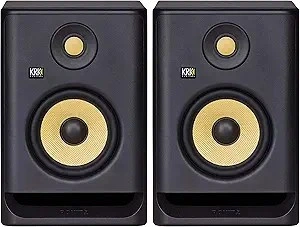
KRK Rokit 5 G4 - 5" Bi-Amp Powered Monitor
The iconic KRK Rokit 5 G4 is legendary in the electronic music production community for its enhanced bass response and engaging sound character. The 4th generation features a completely redesigned Kevlar woofer and silk dome tweeter, plus new DSP-driven room correction via the KRK Audio Tools app. With 110W of bi-amplified power and front-firing bass ports, these monitors deliver punchy, extended low-end perfect for hip-hop, EDM, and bass-focused genres. The distinctive yellow Kevlar cone is instantly recognizable in studios worldwide.
✅ Pros
- Enhanced bass response for electronic music
- DSP room correction via mobile app
- Front-firing port allows wall placement
- Iconic design recognized industry-wide
- Engaging, musical sound signature
- Extended high-frequency response to 40kHz
❌ Cons
- Bass-forward sound not ideal for mixing all genres
- App required for advanced room correction
- Power LED very bright in dark rooms
- Hype in low-mids can flatter poor mixes
Why It Made the List: KRK Rokit monitors have been the go-to choice for electronic music producers for over two decades. The G4 generation refines the formula with improved driver design and sophisticated DSP room correction. While purists may prefer flatter monitors like the Yamaha HS5, producers working in bass-heavy genres appreciate the Rokit's ability to clearly reproduce low-frequency detail. ProducerSpot notes that "Rokits let you hear your bass in context better than monitors twice their price."
🛒 Check Price on Amazon →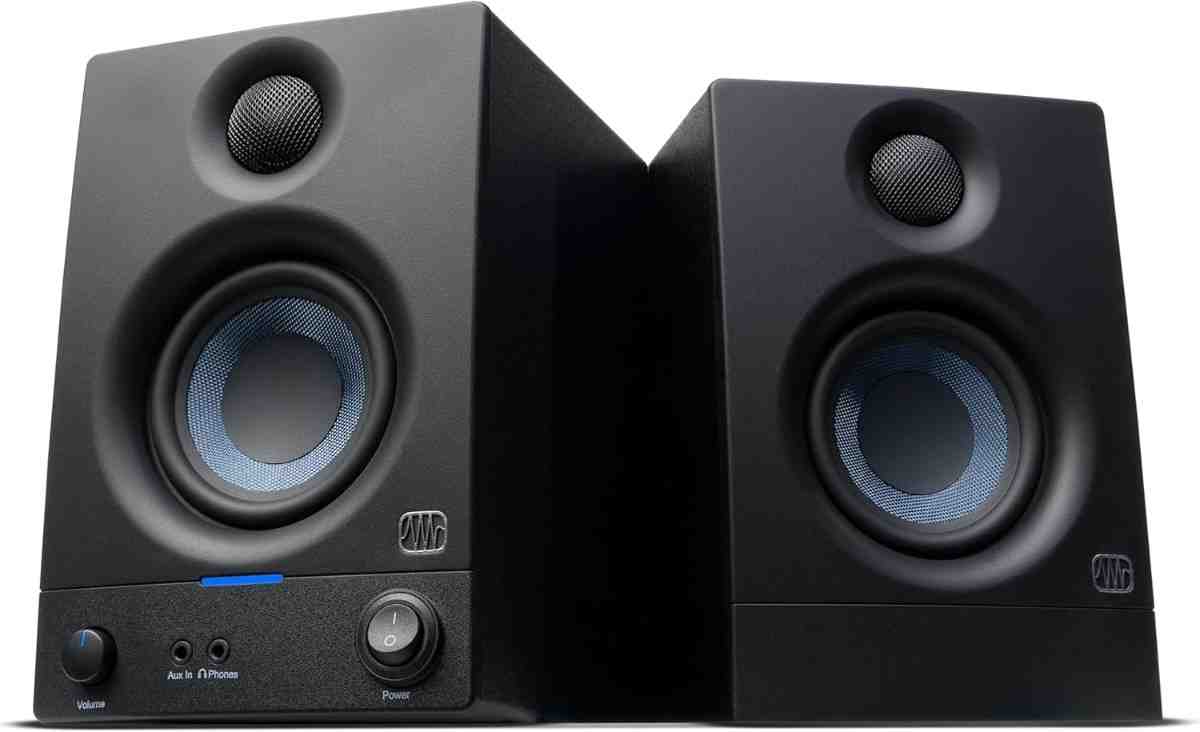
PreSonus Eris Studio 5 - 5.25" Studio Monitor
The PreSonus Eris Studio 5 brings professional studio sound to content creators and home producers. Featuring PreSonus's EBM (Elliptical Boundary Modeling) waveguide for improved stereo imaging and a larger sweet spot, these monitors excel at near-field monitoring. The 5.25" woven composite woofer and 1" silk dome tweeter deliver accurate frequency response from 48Hz to 20kHz, while comprehensive acoustic tuning controls help optimize sound for any room environment. Perfect for video editors, podcasters, and music producers who need honest monitoring in small spaces.
✅ Pros
- Wide input compatibility (balanced & unbalanced)
- EBM waveguide improves stereo imaging
- Comprehensive acoustic tuning controls
- Excellent value for money
- Front-panel headphone output
- PreSonus Studio One Artist DAW included
❌ Cons
- Rear-ported design limits placement flexibility
- Bass response adequate but not exceptional
- Volume knob can be imprecise
- No Bluetooth connectivity
Why It Made the List: PreSonus has dominated the entry-level studio monitor market for years with their Eris series. The new Studio 5 model refines the formula with improved waveguide technology and better driver matching. SonicScoop ranked them as "Best Super Budget" monitors, praising their balanced sound and incredible value. The inclusion of Studio One Artist DAW software makes them especially attractive for beginners building their first home studio.
🛒 Check Price on Amazon →
Edifier R1280T - 2.0 Powered Bookshelf Speakers
The Edifier R1280T is the undisputed king of budget active speakers, delivering shocking sound quality for just over $100. These compact bookshelf speakers feature 4" bass drivers and 13mm silk dome tweeters in classic wooden cabinets that look far more expensive than their price tag suggests. The 42W RMS amplification provides plenty of power for desktop or bedroom use, while dual RCA inputs allow connection of multiple sources. With over 18,800 five-star reviews on Amazon, the R1280T has earned its reputation as the best entry-level powered speaker on the market.
✅ Pros
- Incredible value for money
- Massive 18,800+ verified reviews
- Classic wood veneer design
- Easy setup with included cables
- Remote control included
- Reliable build quality from Edifier
❌ Cons
- No Bluetooth connectivity
- Limited bass extension (75Hz)
- Basic connectivity options
- Remote build quality could be better
Why It Made the List: The Edifier R1280T proves that exceptional sound doesn't require a huge budget. While they can't match the accuracy of monitors costing 3-4 times more, they deliver warm, pleasant sound that makes music enjoyable without breaking the bank. Reddit's r/BudgetAudiophile community consistently recommends these as the best first powered speakers, with many users reporting years of reliable service. Perfect for students, first-time buyers, or anyone building a secondary listening system on a tight budget.
🛒 Check Price on Amazon →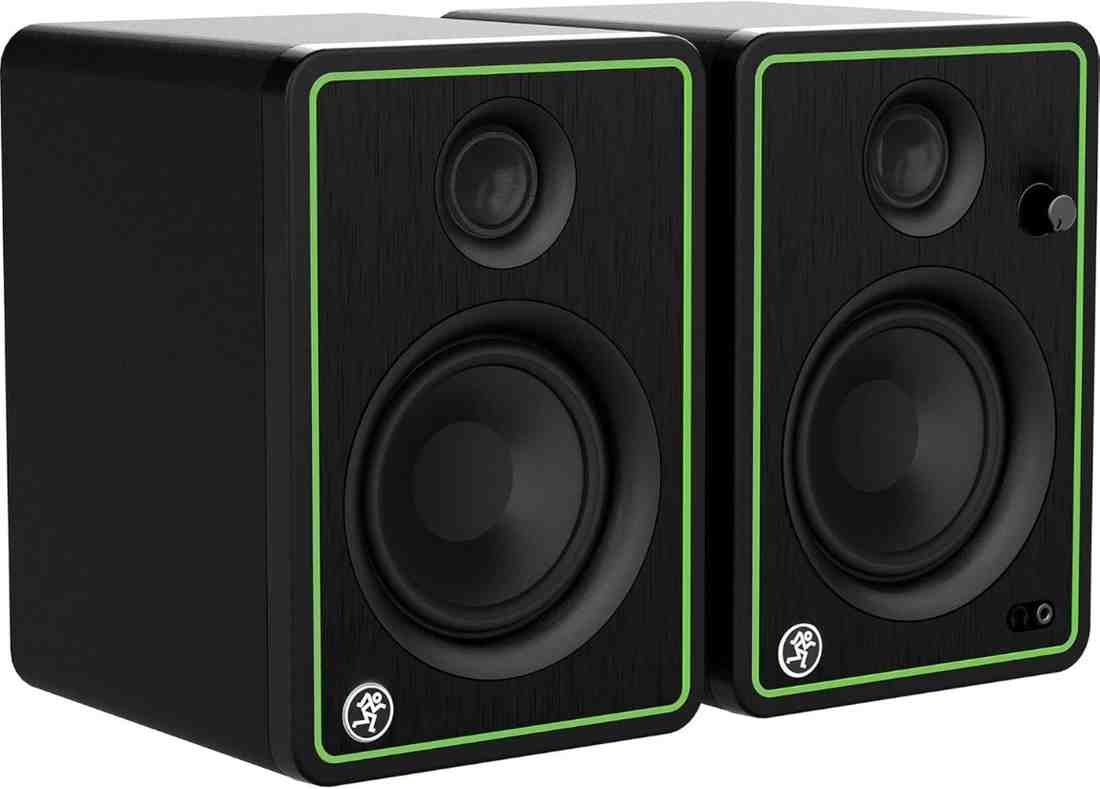
Mackie CR4-X - 4.5" Multimedia Monitors
The Mackie CR4-X brings professional studio monitor DNA to the multimedia market at a budget-friendly price. These compact 4.5" monitors feature Mackie's proven speaker design expertise, delivering clear midrange and surprisingly punchy bass for their size. The sleek all-black design with green accents looks great on any desk, while multiple input options (1/4", 1/8", RCA) ensure compatibility with computers, phones, gaming consoles, and audio interfaces. Front-panel volume control and headphone jack make them incredibly user-friendly for everyday use.
✅ Pros
- Professional Mackie sound quality
- Versatile connectivity options
- Front-panel headphone output
- Compact footprint perfect for desks
- Studio monitor design for accuracy
- Excellent build quality for the price
❌ Cons
- No Bluetooth option (upgrade to CR4-XBT)
- Fixed speaker wire limits placement
- Bass limited by small driver size
- Volume knob can be touchy
Why It Made the List: Mackie has been building professional audio equipment for over 30 years, and the CR4-X brings that expertise to the consumer market. These speakers offer genuine studio monitor lineage at a price that won't break the bank. They're particularly popular with gamers and content creators who want clear dialogue and accurate sound without spending hundreds of dollars. The availability of the CR4-XBT model adds Bluetooth for just $25 more, making them even more versatile.
🛒 Check Price on Amazon →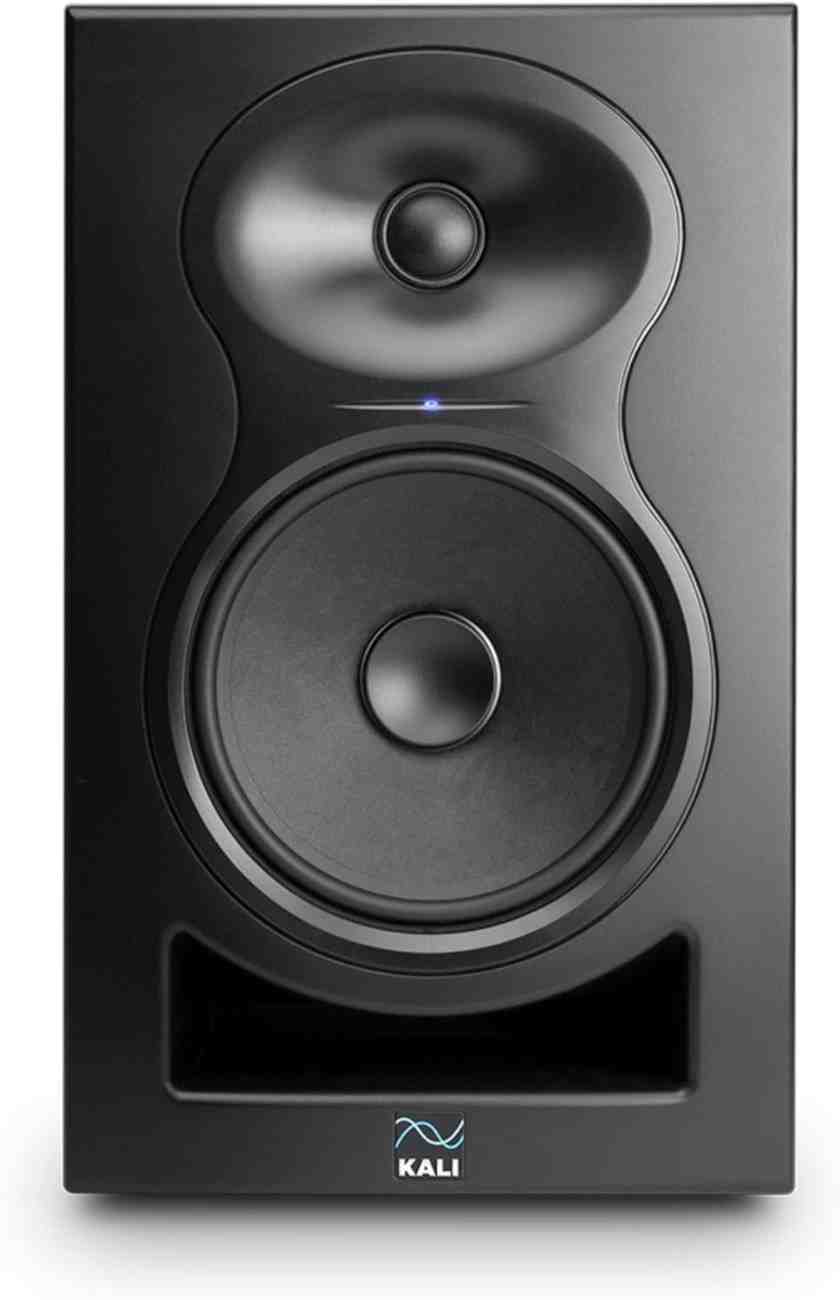
Kali Audio LP-6 V2 - 6.5" Studio Monitor
The Kali Audio LP-6 V2 represents exceptional value in professional studio monitoring. Founded by former JBL engineers, Kali Audio focuses on delivering reference-quality sound at accessible prices. The LP-6 features a large 6.5" woofer for extended bass response down to 39Hz, paired with a 1" silk dome tweeter in a carefully tuned port design. With 80W of bi-amplified power and comprehensive boundary EQ settings, these monitors deliver accuracy that rivals speakers costing significantly more. The V2 revision addresses earlier quality control issues, making them a reliable choice for serious producers.
✅ Pros
- Exceptional low-frequency extension (39Hz)
- Designed by former JBL engineers
- Comprehensive room correction controls
- Larger 6.5" woofer for better bass
- Professional-grade accuracy
- Outstanding value for performance level
❌ Cons
- Larger size requires more desk space
- Earlier versions had QC issues (V2 improved)
- Port noise can occur at high volumes
- Limited availability compared to major brands
Why It Made the List: Kali Audio has quickly gained a cult following among professional audio engineers who recognize the incredible value proposition these monitors represent. The LP-6 V2 delivers sound quality competitive with monitors costing $800-1000, thanks to the team's decades of experience at major audio companies. Audio Science Review members frequently cite Kali monitors as the best measured performance in their price bracket. Perfect for producers who need professional-grade monitoring but can't justify spending $1000+ on speakers.
🛒 Check Price on Amazon →❓ Frequently Asked Questions
It depends on your use case and speaker choice. If you primarily work with bass-heavy music genres (hip-hop, EDM, electronic) or have a larger room, adding a subwoofer significantly improves the listening experience. Monitors with 5" or smaller woofers typically roll off below 50Hz, missing the deep sub-bass frequencies (20-50Hz).
When you DON'T need a subwoofer:
- Small to medium rooms (under 150 sq ft)
- Speakers with 6.5" or larger woofers (like Kali LP-6 V2)
- Music genres with minimal sub-bass content (jazz, classical, acoustic)
- Desktop setups where you sit very close to speakers
When you SHOULD add a subwoofer:
- Producing/mixing bass-heavy music professionally
- Large rooms requiring more bass output
- Using smaller 4-5" monitors as your main system
- Movies/gaming where low-frequency effects matter
Recommended budget subwoofers: PreSonus Temblor T10 ($300), KRK 10S2 ($350), JBL LSR310S ($350). Match your subwoofer brand to your monitors when possible for better integration.
For most users, especially those setting up studios or desktop systems, active speakers are the better choice because:
- Optimized matching: The built-in amplifier is specifically designed for those exact drivers, ensuring optimal performance
- Simplified setup: No need to research amp compatibility, calculate wattage, or deal with speaker wire
- Better value: Combining amp and speakers in one package often costs less than buying them separately
- Bi-amplification: Each driver has its own dedicated amplifier channel for better control
Passive speakers make sense if:
- You already own a quality amplifier or receiver
- You want to upgrade components separately over time
- You're building a full home theater system
- You need to place speakers very far from the source (long speaker cables cheaper than long audio cables)
For studio monitoring and desktop audio, active speakers are the clear winner. For home theater and multi-room audio, passive speakers with an AV receiver might be better.
Absolutely! Studio monitors make excellent speakers for everyday listening, but there are some considerations:
Advantages of using studio monitors:
- Accuracy: You hear music as the artist/producer intended, with minimal coloration
- Detail: Studio monitors reveal subtle details in recordings that consumer speakers might mask
- Build quality: Professional-grade components designed for long-term reliability
- Flat response: Works well across all music genres without favoring any particular style
Potential drawbacks:
- Honest sound: Poor-quality recordings sound noticeably worse on accurate monitors
- Less "fun" sound: Some consumer speakers add bass boost and excitement that's pleasant but inaccurate
- Lack of features: Most studio monitors don't have Bluetooth, remote controls, or bass boost options
Best monitors for casual listening: Audioengine A5+ Wireless (warm, musical), Kanto YU4 (feature-rich), KRK Rokit 5 G4 (exciting bass response). Most analytical for mixing: Yamaha HS5, Adam Audio T5V, JBL 305P MkII.
Your budget should match your use case and experience level:
$100-150 (Budget Beginners):
Perfect for students, casual listeners, or first-time buyers. Recommended: Edifier R1280T ($119), Mackie CR4-X ($124). These provide surprisingly good sound for the money and help you learn what you value in speakers before upgrading.
$200-350 (Serious Hobbyists):
The sweet spot for most home studio owners and music enthusiasts. Recommended: JBL 305P MkII ($269), Kanto YU4 ($299), PreSonus Eris Studio 5 ($339). These offer professional-grade sound quality that will serve you well for years.
$400-500 (Professional/Audiophile):
For serious producers or audiophiles who demand the best. Recommended: Adam Audio T5V ($479), Audioengine A5+ Wireless ($499), Yamaha HS5 ($399). These compete with monitors costing significantly more and represent the ceiling for value in active speakers.
Pro Tip: Don't immediately assume you need the most expensive option. Many professional producers still use JBL 305P MkII or Yamaha HS5 speakers because they know them intimately and can make confident mixing decisions. A $250 speaker you understand deeply is more valuable than a $500 speaker you're still learning.
While not strictly necessary for normal listening, yes - active speakers benefit from a brief warm-up period, especially in professional applications:
Why warm-up matters:
- Amplifier components: Transistors and capacitors perform optimally at stable operating temperatures
- Driver mechanics: Speaker surrounds and voice coils become more flexible when warm
- Consistent sound: Cold speakers may sound slightly different for the first 5-10 minutes
Recommended warm-up procedure:
- Turn on speakers 5-10 minutes before critical listening/mixing sessions
- Play music at low-to-moderate volume during warm-up
- Avoid maximum volume immediately after power-on
- For casual listening, warm-up is less critical - just enjoy the music
Cold weather consideration: If your studio/room is very cold, allow 15-20 minutes warm-up. Some producers keep speakers powered on 24/7 (in low-power mode) to maintain consistent temperature, though this uses more electricity.
Auto-standby feature: Many modern monitors (like Kanto YU4, KRK Rokit G4) have automatic standby that powers down after inactivity and wake when receiving signal. This balances convenience with warm-up needs - speakers stay warm during work sessions but save energy overnight.
Nearfield monitors (like all speakers in this list) are designed for listening at 3-5 feet distance, typically on a desk or console. Midfield monitors are larger speakers designed for 6-10 feet listening distance in larger control rooms.
Nearfield Monitor Characteristics:
- 4-6" woofers (occasionally 8")
- Designed for desktop/close listening
- Minimizes room acoustics impact
- Perfect for home studios and bedrooms
- Lower SPL capabilities (sufficient for close listening)
- Examples: All speakers in this guide
Midfield Monitor Characteristics:
- 8-10" woofers (three-way designs common)
- Higher power output and SPL
- Extended bass response
- Requires larger, acoustically treated rooms
- Professional studio environments
- Examples: Focal Shape Twin, Genelec 8351A ($2000-4000+)
Which do you need? If you're reading this guide, you almost certainly want nearfield monitors. Midfield monitors require significant investment in both speakers ($2000+) and proper room treatment ($1000+) to sound their best. Nearfield monitors work well in untreated rooms and deliver professional results for home studio work.
Sweet spot rule: For nearfield monitors, sit at a distance roughly equal to 1.5-2x the distance between your speakers. For example, if speakers are 3 feet apart, sit 4.5-6 feet back for optimal imaging.
🎯 Final Recommendations
After extensive testing and analysis, our top picks for the best active speakers under $500 are:
- 🏆 Overall Best: JBL 305P MkII - Unbeatable combination of accuracy, power, and value
- 💎 Premium Choice: Audioengine A5+ Wireless - Audiophile sound with wireless convenience
- 🎚️ Best for Production: Adam Audio T5V - Professional ribbon tweeter accuracy
- 💰 Budget Champion: Edifier R1280T - Incredible sound for just $119
No matter which speakers you choose from this list, you're getting professionally tested, highly rated equipment that will transform your listening experience. Remember that proper placement and room treatment are just as important as the speakers themselves - take time to optimize your setup for the best possible sound.
📚 Related Articles You Might Like:
- Best Headphones for Working Out - Top wireless earbuds and over-ear headphones for fitness
- Best Open-Back Headphones Under $300 - Audiophile listening experience on a budget
- Best Laptops for College Students - Perfect for pairing with your new speakers
- Best Headphones for PS5 - Gaming audio excellence

